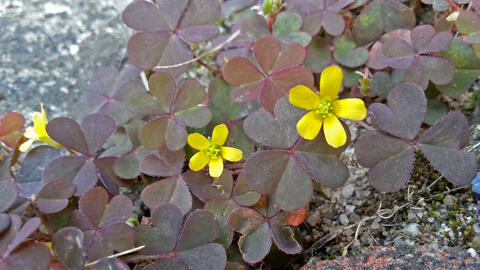Fighting Creeping Woodsorrel in the garden successfully
The Creeping Woodsorrel (Oxalis corniculata) - often simply called Woodsorrel - is one of the most stubborn weeds in the garden. Here we explain how to fight the annoying weed.

Creeping Woodsorrel (Oxalis corniculata) likes to settle in pavement joints
The Creeping Woodsorrel (Oxalis corniculata) originally comes from the Mediterranean area and is considered a Neophyte or archaeophyte in Central Europe, as it has been found in the wine-growing regions of Southern Germany for centuries and is considered naturalized. The Creeping Woodsorrel is a typical example of plants that benefit from increasing climate change. It is native to the Mediterranean and therefore well adapted to longer dry periods; it is spreading further north due to the increasingly dry and hot summers and mild winters. The plant wilts in drought and retreats into its fleshy taproot. As soon as the climate becomes more humid, it sprouts again. The red-brown leaves are also an adaptation to strong sunlight.
The Creeping Woodsorrel has also developed a sophisticated strategy to spread its offspring: When the capsules pop open, it hurls its ripe seeds several feet in all directions. The seeds are also carried away by ants - they feast on the fatty appendage called elaiosome. In addition, the Creeping Woodsorrel spreads in the vicinity via root runners. In the garden, the Creeping Woodsorrel can often be found in lawns and pavement joints, but sometimes also in the flower beds, provided that enough sunlight reaches the ground. It does not thrive in very shady locations.
In most cases,the Creeping Woodsorrel is introduced into the garden by newly purchased plants. Therefore, check the surface of each pot and pluck the Creeping Woodsorrel and its taproot before you plant the new plant in the flower bed. In order to rule out that there are still more seeds in the potting soil, it is best to completely remove the sparsely rooted upper layer of soil and dispose it of in the household waste.
Once the Woodsorrel has planted itself in the garden, it is extremely difficult to get rid of it. So get going as soon as you discover the plant: If it hasn’t flowered yet, it can at least not spread further via seeds. Chop off the plants in the flower bed with a sharp hoe above ground or, ideally, pluck them out of the ground with their roots. The latter, however, is only possible on very light, humus-rich soils - in loamy soil the roots are usually so firmly anchored that the plant tears off at ground level.
If the Woodsorrel grows in individual closed areas, it is worth loosening up the soil bit by bit with a small hand fork and then pulling out the plants along with their roots. After you have rid the flower bed from the plant, you should immediately plant larger open areas with shrubs or ground coverso that the soil soon disappears completely under the plant cover. In addition, you can cover the earth about two inches high with bark mulch to suppress the new shoots.
The Creeping Woodsorrel, which loves warmth and drought, likes to make a home in pavement joints. Here it can of course be fought in the traditional way with a good joint scraper, but this is quite tedious. Torching with a special device is faster. Hold the gas flame on each plant for only one to two seconds - that's enough to destroy the cell structures, even if the Woodsorrel shows hardly any signs of damage on the outside at first. It will die off above ground within the next few days. A root-deep penetration using heat is not possible, so you have to repeat the flaming several times a year.

It is often recommended that the lawn be simply limed when it is interspersed with Creeping Woodsorrel. However, this does not do much, because the Woodsorrel is by no means an acid pointer, although its name suggests that. It also grows without any problems on calcareous soils. However, you need to primarily improve the growth conditions for the lawn grasses if you want to control the Woodsorrel. So first measure the pH of the soil and sprinkle garden lime as per requirement. You should then thoroughly fertilize your lawn. When a green carpet grows about 14 days later, renew your lawn by mowing and dethatching it thoroughly and re-sowing it completely. Where the Creeping Woodsorrel is particularly dense, you should peel off the entire sward flat after dethatching and add some new topsoil. What the Woodsorrel does not like is very moist soils. If necessary, water the newly sown lawn generously until the grass forms a closed seam again.
Hobby gardener must decide for themselves if they wants to use chemical herbicieds for the Creeping Woodsorrel in the garden. Even if these are products that are approved for the home garden, we generally advise against their use. The situation is different with biological products based on acetic acid or pelargonic acid. However, they only corrode the above-ground part of the plant, so the taproot will sprout again after a certain time. It is also important to note that herbicides don’t focus only on unwanted plants in the flower bed - they do not differentiate between "friend and foe". For lawns, on the other hand, there is a chemical preparation that removes dicotyledonous plants, but has no effect on monocotyledonous plants, which include all grasses. By the way: Any herbicide use is strictly prohibited on paved surfaces!


